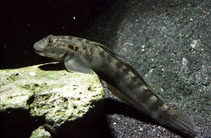| Family: |
Gobiidae (Gobies), subfamily: Sicydiinae |
| Max. size: |
19.8 cm SL (male/unsexed) |
| Environment: |
demersal; freshwater; brackish; marine; depth range 1 - 300 m, amphidromous |
| Distribution: |
Oceania: found in larger Hawaiian Islands and Society Islands. |
| Diagnosis: |
Mature males characterized by an extended ray on the first dorsal fin which is very long and overlaps the second dorsal fin when folded; courting male can appear turquoise to nearly black, with two "racing" stripes along the length of the body; females and juveniles normally mottled brown to gray-green; both sexes turn black when disturbed (Ref. 44091). |
| Biology: |
Benthic in lower and middle reaches of streams (Ref. 58302). Adults inhabit mountainous streams. Are well adapted to exist in swiftly-flowing basalt-bottomed stream habitat (Ref. 26461). Presence of these species signify water of good water quality (Ref. 44091). Adults are primarily herbivorous, scraping algae off rocks, while the larvae are omnivorous; occasionally caught with nets ('upena), usually after being stupefied with native plants (e.g. hola and ahuhu), a process requiring partial diversion of the stream to reduce water flow; particularly prized in July and August when the females are gravid (Ref. 44091). |
| IUCN Red List Status: |
Lower Risk: near threatened (LR/nt); Date assessed: 01 August 1996 Ref. (130435)
|
| Threat to humans: |
harmless |
Source and more info: www.fishbase.org. For personal, classroom, and other internal use only. Not for publication.
